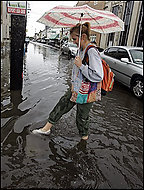The city's drainage pumps were working properly Monday but were unable to keep up with the intense rain, emergency preparedness officials said. They urged motorists to stay off roads.

|
| ©AP Photo/Alex Brandon |
| Lauren Robinson from New Orleans walks through the water in the uptown area of New Orleans on her way to study in a coffeehouse Monday, Oct. 22, 2007. |
In some areas, more than five centimetres of rain fell in an hour, while the city's pumps can handle only a maximum 2 1/2 centimetres in the first hour of a rainfall and just over a centimetre every hour thereafter, said Robert Jackson, a spokesman for the New Orleans Sewerage and Water Board.
"We just have to continue to work with our neighbours until we can develop a greater pump capacity," said Col. Terry Ebbert, director of Homeland Security for the City of New Orleans.
Mayor Ray Nagin shut city hall early and schools across the city closed. Many of the businesses that were soaked had recently reopened after being damaged by 2005's hurricane Katrina.
Making problems worse in New Orleans were catch basins clogged with debris from gutted or renovated homes. Jackson urged residents to clean out the basins to help in draining standing water from streets.
Meanwhile, officials closed a gate on the Harvey Canal in suburban Jefferson Parish where the waters threatened to top the walls. It was one of several in the area placed under new safety guidelines after Katrina's waters breached two New Orleans canals, causing catastrophic flooding.
The corps has worked to strengthen the canal, about eight kilometres from downtown New Orleans, but engineers worried that water being driven into it might lead to flooding. The area around the canal includes homes and businesses.
Unlike the canal walls that broke during Katrina, the walls on the Harvey Canal are not considered at threat of being breached by rising waters, said Chris Accardo, the corps' operations chief.
"The gates were closed to minimize seepage and overtopping," he said.
Moisture from the Gulf of Mexico, ahead of a strong cold front, sparked the swift and strong rainfall that blanketed the area. Bob Wagner, a forecaster with the U.S. National Weather Service, said the rain should slowly diminish Tuesday and bring with it cooler temperatures.
Despite the flooding potential, the rain also offered relief to parts of Louisiana that have been abnormally dry. Until Monday's drenching, rainfall for New Orleans was about 28 centimetres below normal for the year.
The scattered showers and thunderstorms also came as a blessing to other drought-stricken areas of the Southeast. Still, climatologists say it will take more than a few scattered storms to pull the region out of a record drought.
Almost one-third of the U.S. Southeast is covered by an "exceptional" drought - the worst drought category.



Reader Comments
to our Newsletter